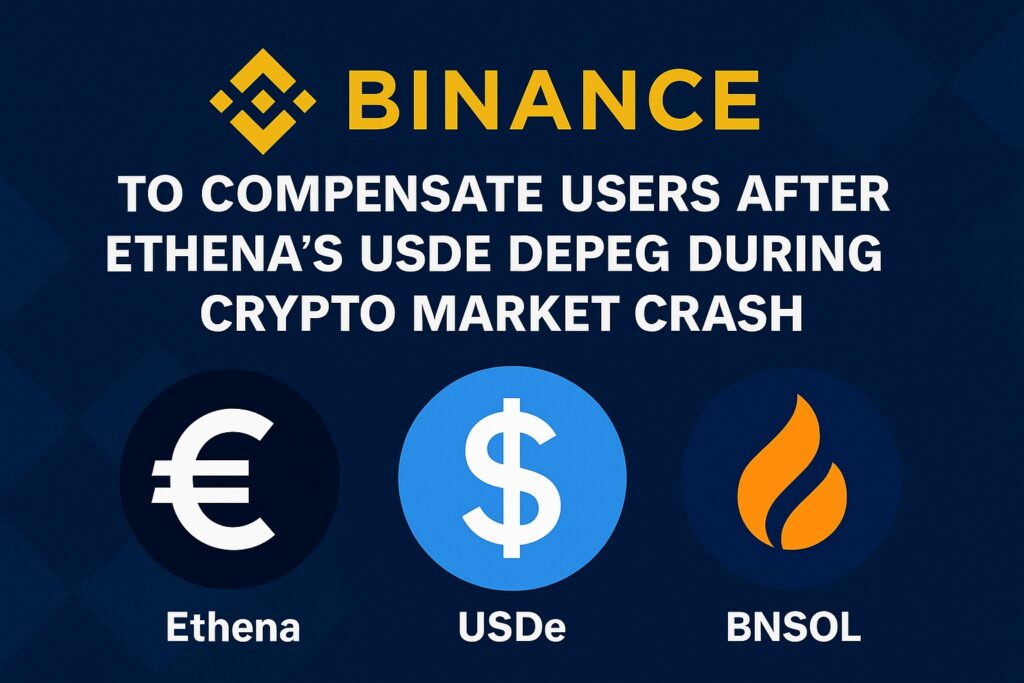The crypto market crash that saw more than $670 billion wiped out of the total market capitalization also marked one of the most volatile trading sessions of the last few years. The event was also followed by the most unexpected outcome to date, the Ethena USDe Depeg, and Binance’s BNSOL staking token and Wrapped Beacon ETH (WBETH). The depeg was followed by multiple liquidations and community uproar over platform reliability during crashes, forcing Binance to later officially announce user compensation via a 72-hour payout plan.
Liquidations Plunge ETH Stablecoin to Record $0.66 Amid USDC Shortage
USDe’s fall from grace occurred amidst an avalanche of liquidations, with the stablecoin designed to be pegged at $1 instead falling to as low as $0.66. It is important to note that the index fell after liquidation engines across centralized exchanges (CEX) were triggered to forcibly close user positions due to the drop in collateral value. The depeg event occurred between 21: 36-22:16 UTC on October 10, a period that saw a major market drop prompted by U.S. President Donald Trump’s approval of 100% tariffs on Chinese imports.
Risk aversion gripped financial markets following his tweet, which compelled traders to liquidate leveraged positions and exacerbate crypto market volatility. All the while, USDe’s price continued to fall well below $1 in response to decreased open interest and technical issues at Binance that delayed traders’ reactions.
CoinGlass revealed that liquidations hit an all-time high on the date, recording close to 1.7 million traders affected by the event and losing more than $19.3 billion in open interest. Binance recorded one of the highest numbers of liquidations with the exchange liquidating $1.4 billion of long and $981 million worth of short positions. During the day’s trading frenzy, many users reported that Binance slowed down significantly, and they were not able to trade as fast as they normally do. These reported issues included problems with order execution, slowed collateral value updates, and difficulties in modifying margin positions on time. This, in turn, stoked user anger and frustration, with several users claiming that they did not just lose funds due to liquidation by the exchange, but also because they were unable to act on the platform due to the reported issues.
Yi He Issues Public Apology on X
Hours after the incident and growing user rage, Binance co-founder and Chief Customer Officer (CCO) Yi He took to X to make an official apology statement to Binance users. Yi He acknowledged that the platform’s operations slowed down during the crash and stated that the team encouraged affected users to contact Binance’s support staff in order to register their cases for review. She reiterated that users would be compensated on a case-by-case basis only for losses incurred as a direct result of the Binance malfunction.
She further added that it would not cover for losses that occurred due to market movements or profits that were unrealized at the time of liquidation. Yi He also stated categorically that the platform would not be reversing trades in which users were able to buy the depegged tokens at dirt-cheap prices, essentially confirming that those users would not lose their tokens.
CEO Teng Follows Up With Platform Improvements
Hours later, Binance CEO Richard Teng also made a public appearance, reiterating Binance’s willingness to be transparent and do right by its users. He assured the platform’s users that Binance would not make excuses, but would listen and try to do better. He also announced that Binance would be implementing several risk control improvements going forward, including adjustments to three of its staking products. These included improving risk controls for BNSOL, WBETH, and USDe by factoring in redemption prices into the index weight calculations.
Binance set a hard floor for USDe at $0.95 to prevent future extreme collapse in price peg and reviewed and improved risk parameter review frequency. The company also announced that it would also be improving the responsiveness of its system under large volume spikes to give users full control of their positions.
72-Hour Payout Plan Announced by Binance
Binance later announced in a blog post that it would release compensations to all eligible users automatically within 72 hours. This compensation would be provided to users who meet the eligibility requirements that fall within the time window. Binance also added that compensation amounts would be calculated based on the difference between the market price at 00: 00 UTC on October 11 and individual users’ forced liquidation price. The official announcement further adds that all Futures, Margin, and Loan users who had USDe, BNSOL, or WBETH as collateral during the eligibility time window will be compensated accordingly. However, those who do not meet the specified time window will be expected to contact customer support staff to have their cases manually reviewed.
What To Expect As Affected Users?
Affected users who will qualify for the automatic compensation scheme are advised to monitor their account balances and wait for the funds to be reflected in their account during the 72-hour window. Binance also announced that the process was automated and eligible users would not be required to take any further manual action. Those who fail to receive their compensation, and still believe that they qualify, will be required to send a support request containing transaction history and time to support staff for verification. Binance further added that documentation would be required in such a case to support the claims, specifically for users who experienced losses outside the specified time window.
Community Reaction to Announcement and Outcome
While some users on social media have lauded the exchange for taking responsibility and offering to compensate users, some users have argued that the events during the trading day raise questions about the centralized liquidation engine and index price being manipulated during volatile periods.
The depeg event has also led to another round of discussions around the security of algorithmic stablecoins like USDe and systemic risks that could manifest when the collateral assets backing the stablecoin rapidly lose value. Many people have continued to argue that CEXs need to improve risk mechanisms and be more transparent in their actions. The view that the market crash has made centralized exchanges riskier and less predictable led to a mention of DeFi as an alternative for predictable liquidation processes during high-volatility periods.
Will Binance Be Harmed?
The recent compensation announcement should not hurt the reputation of the exchange as it is still the world’s largest exchange by trading volume. Binance has a history of reimbursing customers who were on the wrong end of technical issues, an effort that helped Binance keep a loyal user base. Binance’s latest move might also help it earn even more user trust as an exchange that would look out for users during volatile market conditions. The damage for Binance might be related to the highlighted issues with using leverage and cross-collateralization on centralized exchanges and DeFi lending protocols. This should help most retail traders remain cautious of using leverage to the fullest and reevaluate their risk management systems.


